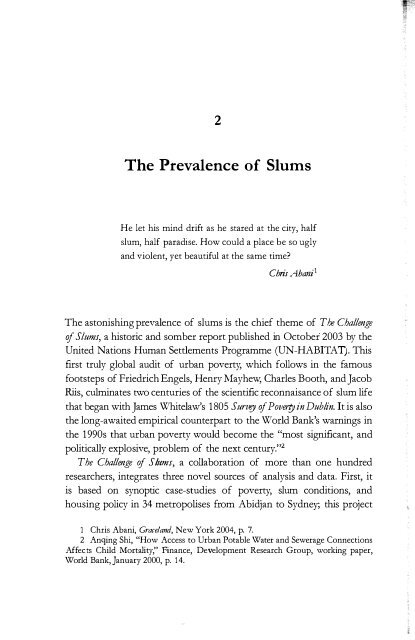Untitled - Rebel Studies Library
Untitled - Rebel Studies Library
Untitled - Rebel Studies Library
Create successful ePaper yourself
Turn your PDF publications into a flip-book with our unique Google optimized e-Paper software.
2<br />
The Prevalence of Slums<br />
He let his mind drift as he stared at the city, half<br />
slum, half paradise. How could a place be so ugly<br />
and violent, yet beautiful at the same time?<br />
Chris Abani1<br />
The astonishing prevalence of slums is the chief theme of The Challenge<br />
of Slums, a historic and somber report published in October 2003 by the<br />
United Nations Human Settlements Programme (UN-HABITAT). This<br />
first truly global audit of urban poverty, which follows in the famous<br />
footsteps of Friedrich Engels, Henry Mayhew, Charles Booth, and Jacob<br />
Riis, culminates two centuries of the scientific reconnaisance of slum life<br />
that began with James Whitelaw's 1805 S urvry of PovertY in Dublin. It is also<br />
the long-awaited empirical counterpart to the World Bank's warnings in<br />
the 1990s that urban poverty would become the "most significant, and<br />
politically explosive, problem of the next century."2<br />
The Challenge of Slums, a collaboration of more than one hundred<br />
researchers, integrates three novel sources of analysis and data. First, it<br />
is based on synoptic case-studies of poverty, slum conditions, and<br />
housing policy in 34 metropolises from Abidjan to Sydney; this project<br />
1 Chris Abani, Grace/and, New York 2004, p. 7.<br />
2 Anqing Shi, "How Access to Urban Potable Water and Sewerage Connections<br />
Affects Child Mortality," Finance, Development Research Group, working paper,<br />
World Bank, January 2000, p. 14.<br />
THE PREVALENCE OF SLUMS 21<br />
was coordinated for UN-HABITAT by the Development Planning<br />
Unit at University College London.3 Secondly, it utilizes a unique<br />
comparative database for 237 cities worldwide created by the UN<br />
HABITAT Urban Indicators Programme for the 2001 Istanbul + 5<br />
Urban Summit.4 And thirdly, it incorporates global household survey<br />
data that breaks new ground by including China and the ex-Soviet bloc.<br />
The UN authors acknowledge a particular debt to Branko Milanovic, the<br />
World Bank economist who pioneered these surveys as a powerful<br />
microscope for studying global inequality. (In one of his papers,<br />
Milanovic explains: "For the first time in human history, researchers<br />
have reasonably accurate data on the distribution of income or welfare<br />
[expenditures or consumption] amongst more than 90 percent of the<br />
world population."5) If the reports of the Intergovernmental Panel on<br />
Climate Change represent an unprecedented scientific consensus on the<br />
dangers of global warming, then The Challenge of Slums sounds an equally<br />
authoritative warning about the worldwide catastrophe of urban poverty.<br />
Bu! _ \Vat _ }s _ _ a "lum"? The first published definition reportedly<br />
occurs in the convict writer James Hardy Vaux's 1812 VocabulClfJI of the<br />
Flash Language, where it is synonymous with "racket" or "criminal<br />
trade."6 By the cholera years of the 1830s and 1840s, however, the poor<br />
were living in slums rather than practicing them. Cardinal Wiseman, in<br />
his writings on urban reform, is sometimes given credit for transforming<br />
"slum" ("room in which low goings-on occurred") from street slang<br />
into a term comfortably used by genteel writers? By mid-century slums<br />
were identified in France, America, and India, and were generally recognized<br />
as an international phenomenon. Connoisseurs and fldneurs<br />
debated where human degradation was most awful: Whitechapel or<br />
3 University College London Development Planning Unit and UN-HABITAT,<br />
Understanding Slums: Case <strong>Studies</strong> for the Global Report on Human Settlements 2003, available<br />
at www.ucl.ac.uk/dpu-projects/Global_Report. Most of these studies are summarized<br />
in an appendix at the back of The Challenge of Slums. Missing, however, is the brilliant<br />
survey of Khartoum by Galal Eldin Eltayeb, deleted, one supposes, because of his<br />
characterization of the "Islamist, totalitarian regime."<br />
4 See Challenge, p. 245.<br />
5 Branko Milanovic, "True World Income Distribution, 1988 and 1993: First<br />
Calculation Based On Household Survey Alone," working paper, World Bank, New<br />
York 1999, n.p.<br />
6 Prunty, Dublin Slums, p. 2.<br />
7 J. A. Yelling, Slums and Slum Clearance in Victorian London, London 1986, p. 5.


